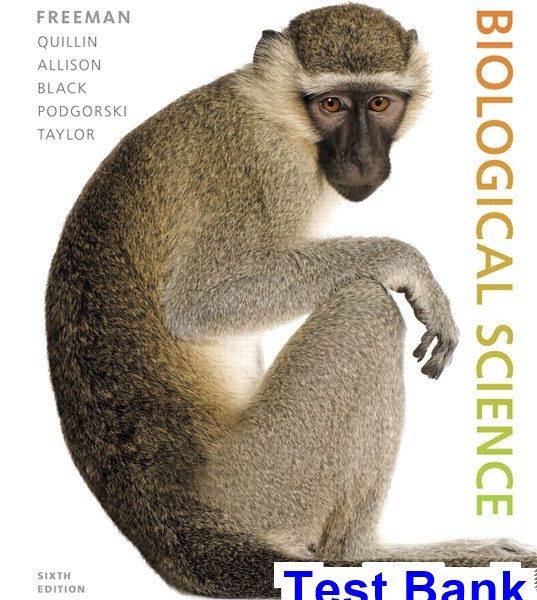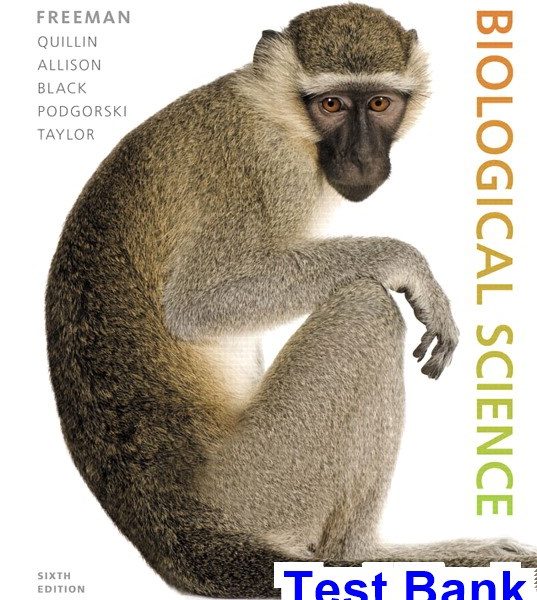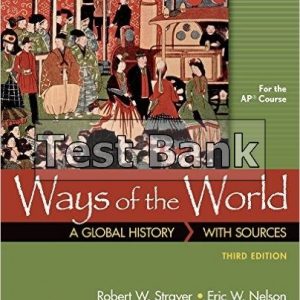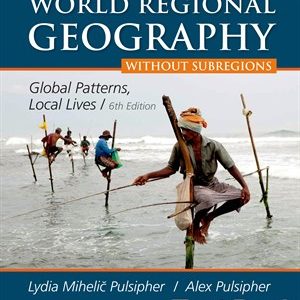This is completed downloadable of Biological Science 6th Edition Freeman Test Bank

Product Details:
- ISBN-10 : 0321976495
- ISBN-13 : 978-0321976499
- Author:
Scott Freeman’s Biological Science is beloved for its Socratic narrative style, its emphasis on experimental evidence, and its dedication to active learning. Science education research indicates that true mastery of content requires a move away from memorization towards active engagement with the material in a focused, personal way. Biological Science is designed to equip students with strategies to assess their level of understanding and identify the types of cognitive skills that need improvement.
With the Sixth Edition, content has been streamlined with an emphasis on core concepts and core competencies from the Vision and Change in Undergraduate Biology Education report. The text’s unique BioSkills section is now placed after Chapter 1 to help students develop key skills needed to become a scientist, new “Making Models” boxes guide learners in interpreting and creating models, and new “Put It all Together” case studies conclude each chapter and help students see connections between chapter content and current, real-world research questions. New, engaging content includes updated coverage of global climate change, advances in genetic editing, and recent insights into the evolution of land plants. Strong media Integration supports book features with MasteringBiology activities, Learning Catalytics™, and new whiteboard videos that guide students in completing “Making Models” assignments.
Table of Content:
1. Biology and the Tree of Life.
The Cell Theory. The Theory of Evolution by Natural Selection. The Tree of Life. Biological Science.
Box 1.1: Scientific Names and Terms.
Box 1.2: Medicine, Economics and the Tree of Life.
Essay: Where Do Humans Fit on the Tree of Life?
UNIT I. THE ORIGIN AND EARLY EVOLUTION OF LIFE.
2. The Atoms and Molecules of Ancient Earth.
The Ancient Earth. The Building Blocks of Chemical Evolution. Chemical Reactions, Chemical Energy, and Chemical Evolution. The Composition of the Early Atmosphere: Redox Reactions and the importance of Carbon. The Early Oceans and the Properties of Water.
Box 2.1: Atomic Mass.
Box 2.2: Bond Types Form a Continuum.
Essay: The Search for Extraterrestrial Life.
3. Macromolecules and the RNA World.
The Start of Chemical Evolution: Experimental Simulations. The Building Blocks of Macromolecules. The First Macromolecules. The First Living Entity.
Box 3.1: How Do Biologists Define Life?
Box 3.2: Gel Electrophoresis and Autoradiography.
Box 3.3: How Proteins Catalyze Reactions.
Box 3.4: Models in Biology: The Double Helix.
Essay: Molecular Handedness and the Thalidomide Tragedy.
4. Membranes and the First Cells.
Lipid Chemistry. Phospholipid Bilayers. Why Molecules Move Across Lipid Bilayers: Diffusion and Osmosis. Membrane Proteins.
Box 4.1: The Transmission Electron Microscope.
Box 4.2: The Scanning Electron Microscope.
Box 4.3: The Fluid-Mosaic Model.
Essay: The Molecular Basis of Cystic Fibrosis.
UNIT II. CELL FUNCTIONS.
5. Cell Structure and Function.
A Tour of theCell. The Nucleus of Nuclear Transport. The Endomembrane System: Synthesis and Distribution of Cellular Products. The Cytoskeleton.
Box 5.1: An Introduction to Centrifugation.
Essay: Organelles and Human Disease.
6. Respiration and Fermentation.
An Overview of Cellular Respiration. Glycolysis. The Krebs Cycle. Electron Transport and Chemiosmosis. Fermentation. How Does Cellular Respiration Interact with Other Metabolic Pathways.
Essay: ATP Production During Exercise.
7. Photosynthesis.
What Is Photosynthesis? How Does Chlorophyll Capture Light Energy? The Photosynthetic Reaction Centers. The Calvin Cycle.
Box 7.1: Types of Plastids.
Box 7.2: Why Was the Oxygen Revolution Important?
Essay: Are Rising CO2 Levels in the Atmosphere Affecting Plant Productivity.
8. Cell Division.
Mitosis and the Cell Cycle. How Does Mitosis Take Place? Control of the Cell Cycle. Cancer: Out-of-Control Cell Division.
Box 8.1: Cell-Culture Methods.
Box 8.2: Cell Division in Bacteria.
Essay: Cancer Chemotherapy.
UNIT III. GENE STRUCTURE AND EXPRESSION.
9. Meiosis.
How Does Meiosis Occur? The Consequences of Meiosis? Why Does Meiosis Exist? Why Sex? Mistakes in Meiosis.
Box 9.1: Karyotyping Techniques.
Box 9.2: Experimental Evidence for Physical Exchange of Chromosome Segments During Crossing Over.
Box 9.3: Recombination in Bacteria.
Essay: Seedless Fruits.
10. Mendel and the Gene.
Mendel’s Experiments with a Single Trait? Mendel’s Experiments with Two Traits. The Chromosome Theory of Inheritance. Testing and Extending the Chromosome Theory. Extending Mendel’s Rules.
Box 10.1: Combining Probabilities.
Box 10.2: Sample Size and Chance Fluctuations.
Essay: Does “Genetic Determinism”Exist?
11. How Do Genes Work?
DNA as the Hereditary Material. What Do Genes Do? The Genetic Code? The Central Dogma of Molecular Biology.
Box 11.1: RNA Genomes: Exceptions to the Central Dogma.
Essay: How Do Viruses Work?
12. DNA Synthesis, Mutation, and Repair.
Testing Early Hypotheses About DNA Replication. A Comprehensive Model for DNA Synthesis. Analyzing DNA Sequences in the Laboratory. The Molecular Basis of Mutation. Repairing Damaged DNA.
Essay: The Genetic Basis of Cancer.
13. Transcription and Translation.
Transcription in Bacteria. Transcription in Eukaryotes. An Introduction to Translation. The of Transfer RNA. The Ribosome. Post-Transitional Events.
Box 13.1: An Introduction to X-Ray Crystallography.
Box 13.2: Prions.
Essay: Transcription, Translation, and Toxins.
14. Control of Gene Expression in Bacteria.
Gene Regulation and Information Flow. Identifying the Genes Involved in Lactose Metabolism. The Discovery of the Repressor. Catabolite Repression and Positive Control. The Operator and the Repressor—An Introduction to DNA-Binding Proteins.
Box 14.1: Gene Transfer in Bacteria.
Box 14.2: Negative Control and Attentuation in the trp Operon.
Box 14.3: DNA Footprinting.
Essay: Controlling the Expression of Disease-Causing Genes.
15. Control of Gene Expression in Eukaryotes.
Mechanisms of Gene Regulation—An Overview. Eukaryotic DNA and the Regulation of Gene Expression. Regulatory Sequences in DNA. Regulatory Proteins. Post-Transcriptional Processing. Linking Cancer with Defects in Gene Regulation.
Box 15.1: Recombinant DNA Technology.
Box 15.2: Southern Blotting.
Essay: Gene Regulation and the Green Revolution.
16. Genomes.
An Introduction to Whole-Genome Sequencing. Bacterial and Archaeal Genomes. Eukaryotic Genomes. Future Prospects.
Box 16.1: Bioinformatics.
Essay: Genomics and Issues of Privacy.
17. Genetic Engineering and its Applications.
Using Recombinant DNA Techniques to Manufacture Proteins: The Effort to Cure Pituitary Dwarfism. Gene Hunting Based on Pedigree Analysis. Can Gene Therapy Cure Inherited Diseases in Humans? Biotechnology in Agriculture.
Box 17.1: Genome Sequencing and Gene Hunting.
Box 17.2: Genetic Testing.
Essay: Controversies over Genetically Modified Foods.
UNIT IV. DEVELOPMENTAL BIOLOGY.
18. An Introduction to Development.
Developmental Stages and Patterns. Does the Genetic Makeup of Cells Changes as Development Proceeds? What Causes Differential Gene Expression?
Essay: Human Cloning.
19. Early Development.
Gametogenesis. Fertilization. Cleavage. Gastrulation.
Box 19.1: Visualizing mRNAs by Situ Hybridization.
Essay: Treating Human Infertility.
20. What Determines a Cell’s Fate?
Pattern Formation in Drosophila. Pattern Formation in Arabidopsis. Differentiation: Becoming a Specialized Cell.
Box 20.1: Maternal Effect Inheritance.
Box 20.2: Programmed Cell Death.
Essay: Human Stem Cells.
UNIT V. EVOLUTIONARY PATTERNS AND PROCESSES.
21. Darwinism and the Evidence for Evolution.
The Evidence for Evolution. How Natural Selection Works. Evolution in Action: Recent Research on Natural Selection.
Box 21.1: The Evidence for Evolution.
Box 21.2: How Natural Selection Works.
Box 21.3: Evolutionary Theory Before Darwin.
Box 21.4: Problems in Estimating the Heritability of Traits.
Essay: The Debate over “Scientific Creationism” .
22. Evolutionary Processes.
Why is Genetic Diversity Important? Analyzing Allele Frequency Change: The Hardy-Weinberg Principle. Mutation. Migration. Inbreeding. Natural Selection. Sexual Selection.
Essay: Evolutionary Theory and Human Health.
23. Speciation.
Defining and Identifying Species. Isolation and Divergence in Sympatry. Isolation and Divergence in Allopatry. Secondary Contact.
Box 23.1: How Do Researchers Estimate Phylogenetic Trees?
Essay: Human Races.
24. The History of Life.
Tools for Studying History. The Cambrian Explosion. The Genetic Mechanisms of Change. Adaptive Radiations. Mass Extinctions.
Box 24.1: The Molecular Clock.
Essay: Is a Mass Extinction Event Under Way Now?
UNIT VI. THE DIVERSIFICATION OF LIFE.
25. Bacteria and Archaea.
What Are the Bacteria and Archaea? Metabolic Diversity in Bacteria and Archaea? Bacteria, Archaea, and Global Change. Bacterial Diseases.
Box 25.1: Cultural Techniques as a Research Tool.
Essay: Antibiotics and the Evolution of Resistance.
26. Viruses.
What Are the Viruses? What Is HIV? How Does and HIV Infection Begin? How Does HIV Replicate Its Genome? How Are Viral Proteins Translated and Processed? How Are Viruses Transmitted to New Hosts?
Box 26.1: Where Did Viruses Come From?
Essay: Emerging Viruses.
27. Protists.
What Are the Protists? Themes in the Evolution of Protists? The Origin of Mitochondria and Chloroplasts. How Do Protists Affect Human Health and Welfare?
Box 27.1: How Should We Name the Tree of Life’s Major Branches?
Essay: Revolutions in Science.
28. Land Plants.
Phylogenies and the Fossil Record: origins and Diversification. The Transition to Land: Key Innovations and Trends. Strategies for Photon Capture. Food, Fuel, and Fiber: Human Use of Pants.
Essay: Genetic Diversity in Crop Plants?
29. Fungi.
What Are the Fungi? Growth, Digestion, and Absorption. Mutualism. Parasitism.
Box 29.1: The Problem of Convergence.
Box 29.2: Fungi at Work.
Essay: Why Are Frogs Dying?
30. Animals.
Origins and Early Diversification. Feeding. Key Innovations in the Radiation of Arthropods. Key Innovations in the Radiation of Vertebrates. Human Evolution.
Essay: So Human An Animal.
UNIT VII. HOW PLANTS WORK.
31. Plant Form and Function.
The Diversity of Plant Form. Cells, Tissues, Organs, and Systems. The Anatomy of Plant Growth. Studying Adaptation.
Box 31.1: Nonvascular Plants.
Box 31.2: Monocots and Dicots.
Box 31.3: Tree-Ring Studies.
Essay: Wood as a Structural Material.
32. Water and Sugar Transport in Plants.
Water Potential and Cell-to-Cell Movement. Transpiration and Water Movement from Roots to Leaves. Translocation.
Essay: Irrigated Agriculture.
33. Plant Nutrition.
Nutritional Requirements. Soil. Nutrient Uptake. Nitrogen Fixation. Nutritional Adaptation of Plants.
Essay: Tropical Soils.
34. Sensory Systems in Plants.
Sensing Light. How Do Plants Perceive Gravity? How Do Plants Respond to Touch?
Essay: Can Plants Tell Time?
35. Communication: Chemical Signals.
Phototropism. Apical Dominance. Growth and Dormancy.
Box 35.1: Cytokinins.
Essay: Herbicides.
36. Plant Reproduction.
An Introduction to Plant Reproduction. Reproductive Structures. Pollination and Fertilization. The Seed.
Box 36.1: Pure and Applied Science.
Essay: Why Do Wasps Try to Copulate with Hammer Orchids?
37. Plant Defense Systems.
Barriers to Entry. Plant Poisons. The Cost of Defense. Responding to Pathogens. Responding to Herbivores.
Essay: Chemical Prospecting.
UNIT VIII. HOW ANIMALS WORK.
38. Animal Form and Function.
The Nature of Natural Selection. The Nature of Adaptation. Tissues, Organs, and Systems: How Does Structure Correlate with Function? Body Size and Scaling. Homeostasis.
Essay: Is Fever Adaptive?
39. Water and Electrolyte Balance in Animals.
Osmotic Stress and Osmoregulation. Water and Electrolyte Balance in Aquatic Environments. Water and Electrolyte Balance in Terrestrial Invertebrates. Water and Electrolyte Balance in Terrestrial Vertebrates.
Essay: Life in the Desert.
40. Animal Nutrition.
Nutritional Requirements. Obtaining Food: The Structure and Function of Beaks, Teeth, and Mouthparts. Digestion. Nutritional Homeostasis—Glucose as a Case Study.
Essay: Cholesterol, Heart Disease, and Diet.
41. Gas Exchange and Circulation.
Air and Water as Respiratory Media. Organs of Gas Exchange. Blood. The Circulatory System. Homeostasis in Blood Pressure and Blood Chemistry.
Box 41.1: Measuring Blood Pressure.
Essay: Smoking and Lung Function.
42. Electrical Signals in Animals.
Principles of Electrical Signaling. Dissecting the Action Potential. The Synapse. The Vertebrate Nervous System.
Box 42.1: The Nernst Equation and the Goldman Equation.
Essay: Can Brain Tissue Transplants Help People with Parkinson’s Disease?
43. Animal Sensory Systems and Movement.
How Do Sensory Organs Convey Information to the Brain? Hearing? Vision? Taste and Smell. Movement.
Box 43.1: Senses that Humans Don’t Have.
Box 43.2: Vertebrate Versus Cephalopod Eyes.
Essay: Sprinters and Marathoners—Born or Made?
44. Chemical Signals in Animals.
Cataloging Hormone Structure and Function. What Do Hormones Do? How Is the Production of Hormones Regulated? How Do Hormones Act on Target Cells?
Box 44.1: A Closer Look at Thyroxine and the Thyroid Gland.
Box 44.2: Oxytocin and ADH.
Essay: Do Humans Produce Pheromones?
45. Animal Reproduction.
Asexual and Sexual Reproduction. Fertilization and Egg Development. Reproductive Structures and Their Functions. The Role of Sex Hormones in Mammalian Reproduction. Human Pregnancy and Birth.
Box 45.1: Unusual Aspects of Fertilization.
Box 45.2: Abuse of Synthetic Steroids.
Essay: Contraception.
46. The Immune System in Animals.
Innate Immunity. The Acquired Immune Response: Recognition. The Acquired Immune Response: Activation. The Acquired Immune Response: Culmination.
Box 46.1: Producing Monoclonal Antibodies.
Box 46.2: How Does the Immune System Distinguish Self from Non-Self?
Box 46.3: The ELISA Test.
Essay: Allergies.
UNIT IX. ECOLOGY.
47. Behavior.
The Role of Genes. How Animals Act: Neural and Hormonal Control. The Adaptive Consequences of Behavior. The Evolution of Behavior.
Box 47.1: Using Reverse Genetics to Study Behavior.
Box 47.2: Conditional Strategies and the Nature/Nurture Debate.
Box 47.3: The Importance of Observation in Behavioral Studies.
Box 47.4: Calculating the Coefficient of Relatedness.
Essay: Children at Risk.
48. Population Ecology.
Population Growth. How Do the Sizes of Populations Change over Time? Population Structure. Demography and Conservation.
Box 48.1: What’s the Best Way to Clean Up an Oil Spill?
Box 48.2: Mark-Recapture Studies.
Essay: What Limits Human Population Growth?
49. Species Interactions.
Parasitism. Predation. Herbivory. Competition. Mutualism.
Essay: Predator Control.
50. Community Ecology.
Climate and the Distribution of Ecological Communities. How Predictable Are Community Assemblages? Species Diversity in Ecological Communities.
Box 50.1: Measuring Species Diversity.
Essay: Let-It-Burn Policies.
51. Ecosystems.
Energy Flow and Trophic Structure. Biogeochemical Cycles.
Essay: Global Warming.
52. Biodiversity and Conservation.
How Many Species Are Being Lost, and Why? Why Should We Care? Setting Conservation Priorities.
Box 52.1: Why Do Small Populations Become Inbred, and Why is Inbreeding Harmful?
Essay: Metaphors for the Future: Easter Island and Guanacaste.
Appendix.
Glossary.
Index.
Combined Volume





